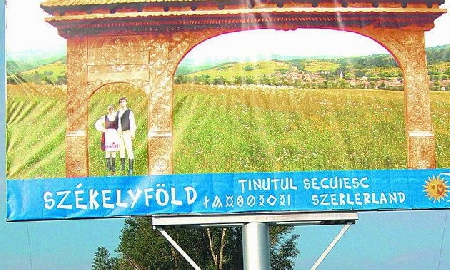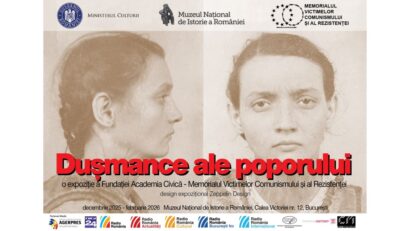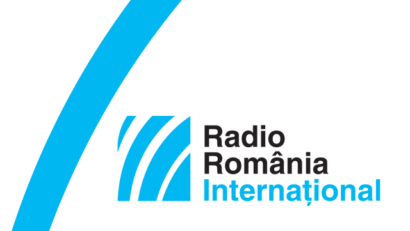The History of the Szeckler flag
An outlook on the history and social perceptions of Szeckler insignia.

Steliu Lambru, 25.02.2013, 12:58
Szecklers are the oldest ethnic minority in Romania, first documented in 1116 in connection with the Pechenegs. They are best known as the avant-garde of the Hungarian cavalry. Skilled warriors in the Middle Ages, Szecklers were colonized by the Kingdom of Hungary towards the Eastern Carpathians, to protect its eastern borders from the invasion of other peoples coming from Asia.
Actually they were first documented within the Carpathian arch in 1210, when an army made up of Szeklers, Saxons, Romanians and Pechenegs took part in the reprisal of the first riot against the Bulgarian Tzar Borila. In the same period, more exactly in 1217, Szecklers are mentioned to form the backbone of the army of Hungarian King Andrew the 2nd, in the fifth crusade against the Arabs.
Since then, Szecklers have been living uninterruptedly on the same territories, in the so-called Szeckler land, comprising the current Romanian counties of Harghita, Covasna and Mures. They account for approximately 45% of the total of 1 million 4 hundred 30 thousand ethnic Hungarians in Romania, which is 6.6% of Romania’s total population.
Academician Pal Antal Sandor is a historian and he’s told us about the place and social status of Szecklers in Medieval Hungary and under the Austrian domination.
Pal Antal Sandor: “As long as they had military duties to perform, they were exempt from paying taxes. The first fiscal obligations to the Royal Court of Hungary were those that had to be paid three times during a king’s reign: upon his enthronement, his marriage and the birth of his heir. That custom was observed until 1555. One in six oxen owned was considered the king’s rightful property. Financial obligations towards a tax authority did not exist until 1657. It was then that the first tax to the Ottomans had to be paid, following Gyorgy Rakoczy the 2nd’s disastrous military campaign. During the Austrian rule, military duties were discarded in 1711 and Szecklers would no longer be called to arms, because their fighting methods had become obsolete. They became taxpayers themselves, but they were free people, with their old rights still observed. They enjoyed the same rights as the nobles under the law.”
After 1989, Szeklers became more visible in the public sphere in a surge of nationalism, more often than not fuelled by perceptions of the past. The latest pretext came in February 2013, when the fact that the Szekler flag was displayed on public institutions in Sfantu Gheorghe, Covasna County, sparked a new scandal, as it was seen as a gesture through which the Szeklers were demanding territorial autonomy on ethnic criteria. Even though it is of recent origin, the Szekler flag has deeper roots. Pal Antal Sandor told us more about how this flag was created.
Pal Antal Sandor: “It was created in 2004 at the initiative of the Szekler National Council, and designed by a curator from Sfantu Gheorghe, Konya Adam. It was inspired by a flag from 1601, a military standard flown by Szekler men of war led by Moise the Szekler, the only prince of Transylvania of Szekler origin. The flag’s yellow and blue are taken from the prince’s coat of arms, while the eight-pointed star is a newer element. Such a star has never been used before, as the other stars used had five or six points. It represents the eight Szekler regions, or royal seats. The crescent, however, is traditional.”
Even though they are old, the Szekler national symbols have never been in continuous use, and have been adjusted to fit the historical circumstances.
Pal Antal Sandor: “Along the centuries, Szeklers of non-Hungarian origin were Hungarized because of their military duties, and had a separate status within the general Hungarian population. They lived on a fairly well defined territory. During the 1848 revolution, the Szeklers intentionally gave up the rights that set them apart from the rest of Hungarians, and integrated into the Hungarian nation. In October 1848, after the gathering in Lutita, the general assembly of Szekler seats adhered to Hungarian law, and declared themselves a part of the single Hungarian nation. Since then, the Szeklers have never used their own flag as part of Hungary.”
After 1918, when Greater Romania emerged, Szekler insignia were put on the flag as part of the crest of Transylvania. Few people know that Szekler symbols are the same with those on the crests of medieval Romanian principalities.
Pal Antal Sandor: “I am still waiting to see the response of Romanian historians on this matter. But one has to ask: what is the origin of these symbols? In any case, they are Eastern, Turkish. Turkic populations have used these symbols, and let us not forget that Wallachia was under Cumanian domination for 200 years. Of course these symbols appeared in Wallachian heraldry. Moldavia is likely to use them as well. I am not saying this is set in stone, but I have to ask myself that. The crescent is everywhere, but instead of the sun there may be a star.”
The Szeklers are a minority with a strong ethnic awareness, which they plan to preserve. For them national insignia carry the same weight as for any other ethnic group and nation.






























